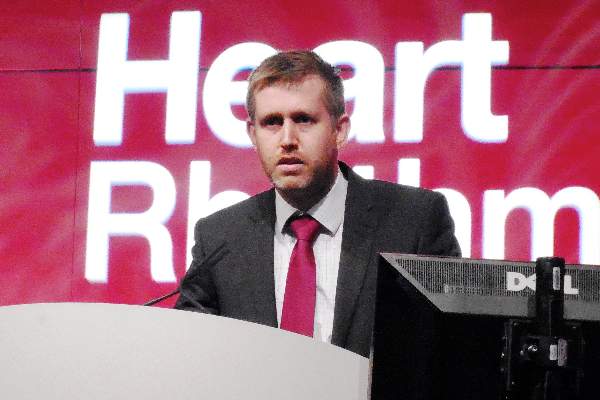User login
BOSTON – Adding extra ablation lines on top of pulmonary vein isolation treatment of persistent atrial fibrillation failed to improve patient outcomes but prolonged treatment and exposed patients to significantly more fluoroscopy and radiation in results from a multicenter, randomized trial with 124 patients.
“In patients with presumed substrate-based AF, adding linear ablation lesions to wide area circumferential ablation of the pulmonary vein provides no additional clinical benefit,” and carries the downside of longer procedures with increased fluoroscopy and radiation exposure, Dr. Gareth J. Wynn said at the annual scientific sessions of the Heart Rhythm Society.
“A few years ago, people were saying you need additional ablation lines, but these results and prior reports suggest that just pulmonary vein isolation [PVI] is sufficient,” commented Dr. Fred M. Kusumoto, an electrophysiologist and professor at Mayo Clinic, Florida in Jacksonville.
The study run by Dr. Wynn and his associates at three U.K. centers randomized 122 intention-to-treat patients considered to have a high likelihood of substrate-based AF, defined as either persistent AF of less than 1 year’s duration or sustained AF episodes plus at least one comorbidity that increases persistent AF risk. The study excluded patients who had previously undergone ablation as well as those with persistent AF beyond 1 year. The patients’ average age was 62 years; two-thirds were men, and 61% had persistent AF.
All patients underwent PVI by wide-area circumferential ablation, and those randomized to the added-treatment group also received ablation along the left atrial root, the mitral isthmus, and the cavotricuspid isthmus. The ablation procedures used “modern technology,” Dr. Wynn said, including three-dimensional electroanatomic mapping and contact-force sensing catheters. Bidirectional block in all three attempted lines occurred in 81% of patients randomized to that treatment. All patients received an antiarrhythmic drug, either flecainide or amiodarone for about 6 weeks before and for 6 weeks after ablation.
Patients in the PVI plus linear ablation group had procedures that took an average of 37 minutes longer, a 22% increase in time compared with PVI only. Patients who received linear ablations also had a nearly 50% average increase in their fluoroscopy time, and their average radiation exposure nearly doubled the amount used on the PVI-only patients.
Despite the longer, more involved procedures, patients who received the extra ablations had about as many recurrent AF or atrial tachycardia cases as patients treated with PVI only, reported Dr. Wynn, an electrophysiologist at the Liverpool (U.K.) Heart and Chest Hospital. After 1 year of follow-up, recurrent events occurred in 32% of those who received PVI only and in 38% of those who also received linear ablations, the study’s primary endpoint. Patients who received the linear ablations also showed no improvement in their quality of life assessments of both mental and physical status compared with the PVI-only patients.
On Twitter @mitchelzoler
Controversy has existed for years over whether one should add some linear lesions when performing pulmonary vein isolation for atrial fibrillation, especially in patients with more persistent AF. Adding linear ablations takes more time and perhaps puts patients at additional risk with more fluoroscopy and radiation. The results from Dr. Wynn’s study showed that adding the extra ablation lines did not improve outcomes, and this confirms similar findings previously reported from other studies.
 |
| Mitchel L. Zoler/Frontline Medical News Dr. Andrea M. Russo |
I believe that all these data collectively will have a significant impact on future ablation treatment for atrial fibrillation. Everyone agrees about performing pulmonary vein isolation. These new results will help make electrophysiologists more selective about also using linear ablations. There is certainly no need to perform them in all patients. We need to figure out when it is better to add something to PVI, and when PVI alone is sufficient.
Dr. Andrea M. Russo is professor and director of the electrophysiology and arrhythmia service at Cooper University Hospital in Camden, N.J. She made these comments in an interview. Dr. Russo has been a consultant to St. Jude, Biotronik, Boston Scientific and Medtronic.
Controversy has existed for years over whether one should add some linear lesions when performing pulmonary vein isolation for atrial fibrillation, especially in patients with more persistent AF. Adding linear ablations takes more time and perhaps puts patients at additional risk with more fluoroscopy and radiation. The results from Dr. Wynn’s study showed that adding the extra ablation lines did not improve outcomes, and this confirms similar findings previously reported from other studies.
 |
| Mitchel L. Zoler/Frontline Medical News Dr. Andrea M. Russo |
I believe that all these data collectively will have a significant impact on future ablation treatment for atrial fibrillation. Everyone agrees about performing pulmonary vein isolation. These new results will help make electrophysiologists more selective about also using linear ablations. There is certainly no need to perform them in all patients. We need to figure out when it is better to add something to PVI, and when PVI alone is sufficient.
Dr. Andrea M. Russo is professor and director of the electrophysiology and arrhythmia service at Cooper University Hospital in Camden, N.J. She made these comments in an interview. Dr. Russo has been a consultant to St. Jude, Biotronik, Boston Scientific and Medtronic.
Controversy has existed for years over whether one should add some linear lesions when performing pulmonary vein isolation for atrial fibrillation, especially in patients with more persistent AF. Adding linear ablations takes more time and perhaps puts patients at additional risk with more fluoroscopy and radiation. The results from Dr. Wynn’s study showed that adding the extra ablation lines did not improve outcomes, and this confirms similar findings previously reported from other studies.
 |
| Mitchel L. Zoler/Frontline Medical News Dr. Andrea M. Russo |
I believe that all these data collectively will have a significant impact on future ablation treatment for atrial fibrillation. Everyone agrees about performing pulmonary vein isolation. These new results will help make electrophysiologists more selective about also using linear ablations. There is certainly no need to perform them in all patients. We need to figure out when it is better to add something to PVI, and when PVI alone is sufficient.
Dr. Andrea M. Russo is professor and director of the electrophysiology and arrhythmia service at Cooper University Hospital in Camden, N.J. She made these comments in an interview. Dr. Russo has been a consultant to St. Jude, Biotronik, Boston Scientific and Medtronic.
BOSTON – Adding extra ablation lines on top of pulmonary vein isolation treatment of persistent atrial fibrillation failed to improve patient outcomes but prolonged treatment and exposed patients to significantly more fluoroscopy and radiation in results from a multicenter, randomized trial with 124 patients.
“In patients with presumed substrate-based AF, adding linear ablation lesions to wide area circumferential ablation of the pulmonary vein provides no additional clinical benefit,” and carries the downside of longer procedures with increased fluoroscopy and radiation exposure, Dr. Gareth J. Wynn said at the annual scientific sessions of the Heart Rhythm Society.
“A few years ago, people were saying you need additional ablation lines, but these results and prior reports suggest that just pulmonary vein isolation [PVI] is sufficient,” commented Dr. Fred M. Kusumoto, an electrophysiologist and professor at Mayo Clinic, Florida in Jacksonville.
The study run by Dr. Wynn and his associates at three U.K. centers randomized 122 intention-to-treat patients considered to have a high likelihood of substrate-based AF, defined as either persistent AF of less than 1 year’s duration or sustained AF episodes plus at least one comorbidity that increases persistent AF risk. The study excluded patients who had previously undergone ablation as well as those with persistent AF beyond 1 year. The patients’ average age was 62 years; two-thirds were men, and 61% had persistent AF.
All patients underwent PVI by wide-area circumferential ablation, and those randomized to the added-treatment group also received ablation along the left atrial root, the mitral isthmus, and the cavotricuspid isthmus. The ablation procedures used “modern technology,” Dr. Wynn said, including three-dimensional electroanatomic mapping and contact-force sensing catheters. Bidirectional block in all three attempted lines occurred in 81% of patients randomized to that treatment. All patients received an antiarrhythmic drug, either flecainide or amiodarone for about 6 weeks before and for 6 weeks after ablation.
Patients in the PVI plus linear ablation group had procedures that took an average of 37 minutes longer, a 22% increase in time compared with PVI only. Patients who received linear ablations also had a nearly 50% average increase in their fluoroscopy time, and their average radiation exposure nearly doubled the amount used on the PVI-only patients.
Despite the longer, more involved procedures, patients who received the extra ablations had about as many recurrent AF or atrial tachycardia cases as patients treated with PVI only, reported Dr. Wynn, an electrophysiologist at the Liverpool (U.K.) Heart and Chest Hospital. After 1 year of follow-up, recurrent events occurred in 32% of those who received PVI only and in 38% of those who also received linear ablations, the study’s primary endpoint. Patients who received the linear ablations also showed no improvement in their quality of life assessments of both mental and physical status compared with the PVI-only patients.
On Twitter @mitchelzoler
BOSTON – Adding extra ablation lines on top of pulmonary vein isolation treatment of persistent atrial fibrillation failed to improve patient outcomes but prolonged treatment and exposed patients to significantly more fluoroscopy and radiation in results from a multicenter, randomized trial with 124 patients.
“In patients with presumed substrate-based AF, adding linear ablation lesions to wide area circumferential ablation of the pulmonary vein provides no additional clinical benefit,” and carries the downside of longer procedures with increased fluoroscopy and radiation exposure, Dr. Gareth J. Wynn said at the annual scientific sessions of the Heart Rhythm Society.
“A few years ago, people were saying you need additional ablation lines, but these results and prior reports suggest that just pulmonary vein isolation [PVI] is sufficient,” commented Dr. Fred M. Kusumoto, an electrophysiologist and professor at Mayo Clinic, Florida in Jacksonville.
The study run by Dr. Wynn and his associates at three U.K. centers randomized 122 intention-to-treat patients considered to have a high likelihood of substrate-based AF, defined as either persistent AF of less than 1 year’s duration or sustained AF episodes plus at least one comorbidity that increases persistent AF risk. The study excluded patients who had previously undergone ablation as well as those with persistent AF beyond 1 year. The patients’ average age was 62 years; two-thirds were men, and 61% had persistent AF.
All patients underwent PVI by wide-area circumferential ablation, and those randomized to the added-treatment group also received ablation along the left atrial root, the mitral isthmus, and the cavotricuspid isthmus. The ablation procedures used “modern technology,” Dr. Wynn said, including three-dimensional electroanatomic mapping and contact-force sensing catheters. Bidirectional block in all three attempted lines occurred in 81% of patients randomized to that treatment. All patients received an antiarrhythmic drug, either flecainide or amiodarone for about 6 weeks before and for 6 weeks after ablation.
Patients in the PVI plus linear ablation group had procedures that took an average of 37 minutes longer, a 22% increase in time compared with PVI only. Patients who received linear ablations also had a nearly 50% average increase in their fluoroscopy time, and their average radiation exposure nearly doubled the amount used on the PVI-only patients.
Despite the longer, more involved procedures, patients who received the extra ablations had about as many recurrent AF or atrial tachycardia cases as patients treated with PVI only, reported Dr. Wynn, an electrophysiologist at the Liverpool (U.K.) Heart and Chest Hospital. After 1 year of follow-up, recurrent events occurred in 32% of those who received PVI only and in 38% of those who also received linear ablations, the study’s primary endpoint. Patients who received the linear ablations also showed no improvement in their quality of life assessments of both mental and physical status compared with the PVI-only patients.
On Twitter @mitchelzoler
AT HEART RHYTHM 2015
Key clinical point:Linear ablation lines provided no added benefit to patients with persistent atrial fibrillation who underwent atrial ablation to produced pulmonary vein isolation.
Major finding: After 1 year, recurrent AF occurred in 32% treated with PVI and 38% treated with PVI plus linear ablations.
Data source: Randomized trial of 122 patients with persistent AF for less than 1 year at three U.K. centers.
Disclosures: Dr. Wynn and Dr. Kusumoto had no disclosures.


